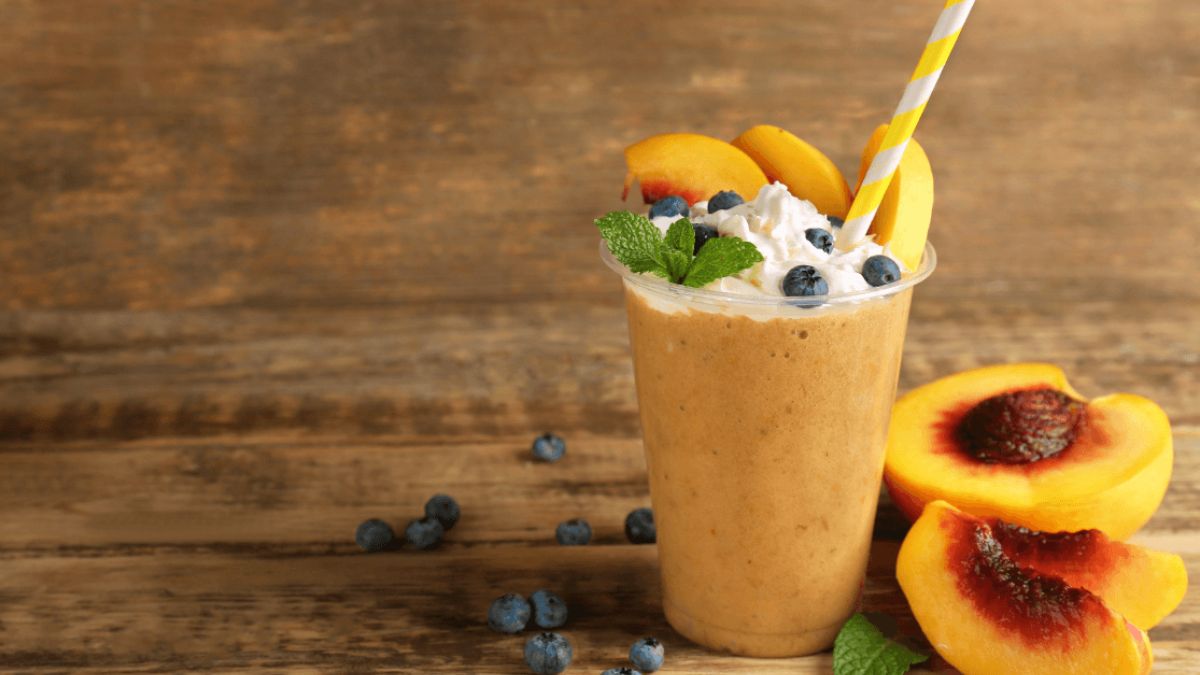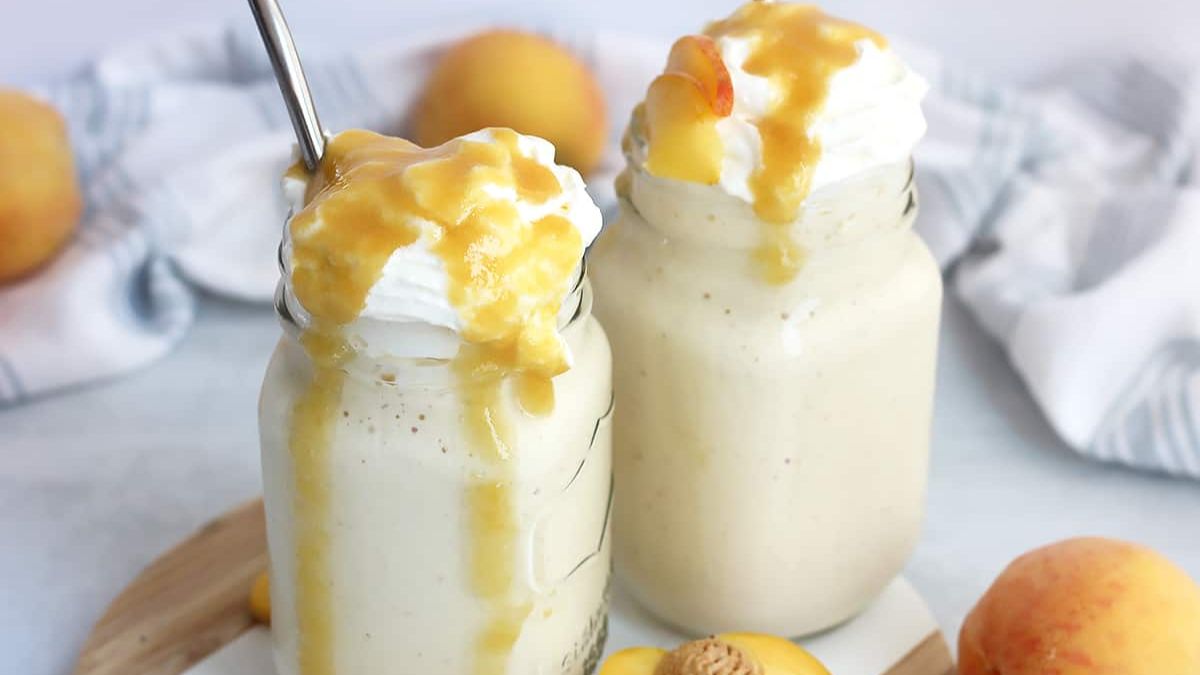Make your milkshake at home if you want it to be healthy. Regular milkshake consumption may result in weight gain, dyslipidemia [high level of fatty substances in the blood], and higher blood glucose levels. Peel and pit the peaches before blending them with the milk to produce this delicious peach milkshake. After reaching the desired smooth consistency, add your ice cream and a little more milk to the blender. Then it’s prepared for serving!
Homemade Peach Milkshake Recipe
Why wait to get a milkshake until you’re at a diner? You can make them home with ice cream, milk, and flavors. Even though chocolate or vanilla may be the first thing that comes to mind, fresh fruit makes a tasty milkshake. This homemade peach milkshake recipe tastes like summer in a tall glass, and it makes enough for two big shakes if you’re willing to share. But if you want to make a quick shake, it’s easy to cut the recipe in half. One of the best things about making your desserts at home is that you can add your twist or only make as much as you need.
Ingredients
- Two large peaches
- 2 cups vanilla ice cream, more to taste
- 1/2 cup milk, more to taste
Steps to Make it
- Gather the ingredients.
- Remove the pit and peel from the peaches, then cut them into big chunks.
- Use a blender to make a smooth paste out of the peaches.
- Put the milk and ice cream in the blender. Blend to mix. Check the shake’s texture to see if it needs more ice cream or milk to get the right consistency.
- Pour the shake into two glasses that have been kept cold.
Additional Tips
- If you puree the peaches first, you won’t have chunks of peach in your milkshake. So, the fruit will blend well, and the milkshake will be smooth.
- This is a great way to use up fruit that has gone bad. When your peaches are getting too soft to eat on their own, it’s the perfect time to make a shake with them. Two sweet peaches and some good vanilla ice cream will give the shakes plenty of sugar. As a bonus, if you use very ripe fruit, you won’t need to add any extra sugar to this recipe.
- In this recipe, you can use either fresh or frozen peaches. If you don’t let the fruit thaw, your milkshake will be too thick to drink. On the other hand, it will taste like peach ice cream, which isn’t bad.
- You might not think to put grilled fruit in a milkshake, but grilled peaches have a new taste. Cooking the fruit will bring out its sweetness and give it a hint of smoke. If you are grilling dinner, cut your peaches in half and toss them on the grill until they get good marks. Let the peaches cool down, and then keep going with the recipe.
- Add a dollop of whipped cream and a slice of fresh peach to the top of the milkshake for a little extra decadence. A sprig of mint is also a nice touch that feels like summer.
Is Peach Milkshake Good for Health?
Beta-carotene, lutein, and zeaxanthin are three carotenoids (provitamin A) found in many peaches. Several studies have found that eating foods high in carotenoids is linked to a lower risk of getting diseases like cancer and heart disease. Yes, nutritious! People think of milkshakes as junk food, but that’s not true. Since milkshakes are made of milk, they are healthy right away.
Protein in Milkshakes
We all know that milk helps to strengthen our bones. Whey protein molecules are found in milk. Our body needs whey to maintain the protein flowing to the bones and muscles. No, all fats are not harmful. Milk’s fat content aids in controlling body temperature, particularly on cold days and throughout the winter.
Carbohydrates in Milkshakes
Sugar is an additional component of a milkshake. Sugar is beneficial in moderation. Sugar gives the brain the quick energy it needs to work effectively. It is also a wonderful source of fiber if you want a fruity milkshake like the Heritage Strawberry Milkshake. Fruits typically include vitamin C, which strengthens immunity.
Improved Digestion
According to Smith, peaches have both soluble and insoluble fiber. “Soluble fiber controls cholesterol levels and aids in blood sugar stabilization. Constipation can be avoided, and digestion is aided by insoluble fiber. The fruit’s skin can help you get the most fiber per serving.
Peaches may also be helpful for your stomach in ways other than just fiber. According to research, peach flower extracts and tea may aid in better digestion.
Does Peach Increase Weight?
Peaches help speed up your metabolism because they have flavonoids like catechins, which speed up your metabolism. A faster metabolism also helps burn calories, making losing weight easier. Peaches won’t make you lose weight like magic, but they can help you lose a few pounds. They are a great low-calorie snack, and adding them to oatmeal or pancakes makes your healthy breakfast taste even better.
Do Milkshakes Make you Fat?
If you eat 500 to 1,000 calories more each day than you burn, you’ll gain 1 to 2 pounds per week. Milkshakes are a quick and tasty way to add calories to your diet. Most versions from restaurants and fast food places are full of processed sugar and unhealthy fats that can still cause health problems for underweight people—gaining one to two pounds per week results in consuming 500 to 1,000 calories more than you expend daily. A delightful and convenient approach to increasing your calorie intake is with milkshakes. Versions from restaurants and fast food chains are frequently packed with processed sugar and bad fats that can still harm an underweight person’s health.
How to Pick and Store a Peach?
Let your peaches mature at room temperature for a few days if they are quite solid and don’t have any aroma. Put ripe peaches in the refrigerator to prevent them from going rotten. Fresh peaches can also be cut into slices and frozen for later use.
According to Smith, fresh peaches often have more antioxidants than their canned counterparts, and canned peaches frequently have their fuzzy, soft skin removed. This is a missed opportunity because this is where many of the antioxidants are located. Additionally, peaches in cans are frequently steeped in sweet syrup. To prevent extra sugars when choosing canned peaches, read the nutrition label.
Once ripe, peaches should be stored in a bag with lots of holes or, if not in the refrigerator, in an open bag separate from other fruits. After cutting them up, the easiest thing to do with your peaches is to wrap them tightly and store them in the refrigerator.
Refrigerating ripening fruit can result in internal discoloration, flavor, texture, and moisture loss. When peaches are ripe, wash them under running water and, if you choose, gently wipe the “fuzz” off. Place in a plastic bag and keep in the refrigerator. Ripe peaches can be stored in the fridge for 3 to 5 days.
Can you Lose Weight by Drinking Milkshakes?
Fortunately, milkshakes are a healthy beverage if refined sugar is avoided. According to a recent American Journal of Clinical Nutrition study, drinking some kinds of milkshakes can keep people full between breakfast and lunch, lowering caloric intake throughout the day. Therefore, milkshakes might aid in weight loss. In fact, according to some research, milkshakes can help you lose weight by keeping you satisfied between meals. So, if you enjoy milkshakes, feel free to experiment with new recipes throughout the lockdown without worrying about your weight.
Can you Use Frozen Peaches in a Milkshake?
No need to give in to your desire for a milkshake if fresh peaches are not in season or easily accessible. The peach season doesn’t last very long; thus, frozen peaches are preferable to fresh ones that lack flavor. To avoid having too much water and mushy peaches, you might wish to let the peaches thaw overnight in the refrigerator before using them in this recipe. And never, ever put frozen peaches to defrost in the microwave. That will only ruin the flavor and make a mess!
How Long does a Fresh Peach Shake Last?
A fresh peach smoothie won’t freeze for up to two hours when kept in the freezer. The longer you keep it in the freezer, the more solidly it will freeze. A large number of milkshakes could be prepared and briefly frozen before serving.
Conclusion
Your taste buds might love a chocolate milkshake, but it’s not so good for your blood vessels. A new study suggests that eating just one high-fat meal or food item, like a milkshake, may cause your blood vessels and red blood cells to change in a way that isn’t good for you.
A study in the American Journal of Clinical Nutrition found that thick milkshakes like this one can keep you satisfied between meals, so you don’t overeat or eat too frequently, which is another factor that contributes to weight gain. Although a delectable treat goes well with a burger and fries, a thick, creamy milkshake is not a healthy option. While milkshakes do provide some calcium that helps build bones, they are also very heavy in fat, especially saturated fat.

